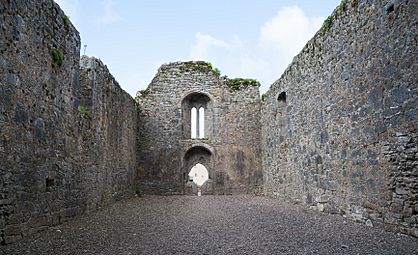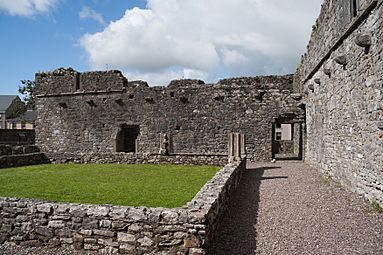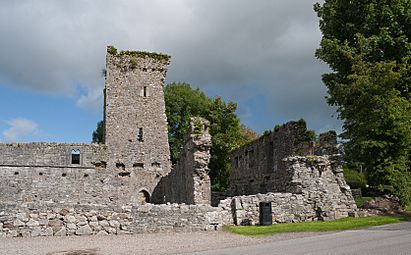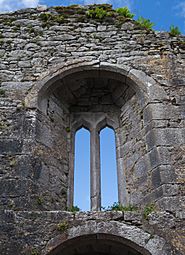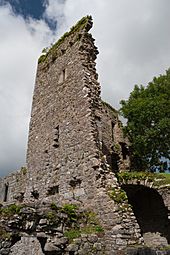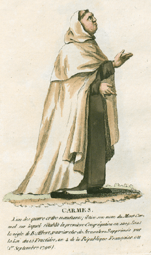Castlelyons Friary facts for kids
| Prióireacht Chaisleán Ó Liatháin | |

East wing
|
|
| Monastery information | |
|---|---|
| Other names | Castelio, Castleyhane, Castelleaghan, Castrileonensis |
| Order | Carmelites |
| Established | 1307–09 / 1324 |
| Disestablished | 1760 |
| Diocese | Cloyne |
| People | |
| Founder(s) | John de Barry, 4th Baron Barry |
| Architecture | |
| Status | ruined |
| Style | Norman |
| Site | |
| Location | Mohera, Castlelyons, County Cork |
| Coordinates | 52°05′21″N 8°14′01″W / 52.089148°N 8.233480°W |
| Public access | yes |
| Official name | Castlelyons Friary |
| Reference no. | 411 |
Castlelyons Friary is an old Carmelite monastery located in County Cork, Ireland. It's also a special National Monument, meaning it's protected because of its historical importance.
Contents
Where is Castlelyons Friary?
Castlelyons Friary is found in County Cork, Ireland. It is about 6.6 kilometers (4 miles) south-southeast of Fermoy. The friary is also located south of the Munster Blackwater river.
The History of Castlelyons Friary
How the Friary Started
The Carmelite friary at Castlelyons was founded around 1307–1309. A powerful person named John de Barry, 4th Baron Barry started it. He got permission from King Edward II to give land for the Carmelites.
Later, in 1324, Pope John XXII also gave his permission. This allowed the friary to be built properly. The friary was even given money each year from the local townspeople.
What's in a Name?
The name "Castlelyons" might make you think of lions, but it has nothing to do with them! It comes from an old kingdom called Uí Liatháin, which was in this area long ago.
Building the Friary
When it was first built, the friary had a small church. This church was dedicated to the Blessed Virgin Mary. Over time, the friary grew bigger. A nave (the main part of a church), a cloister (a covered walkway), and a tower were added.
Changes Over Time
In 1541, during the time of King Henry VIII, many monasteries in England and Ireland were closed down. This was called the Dissolution of the Monasteries. Castlelyons Friary was closed and became property of the king.
Later, in 1568, the land was given to James de Barry, 4th Viscount Buttevant. In 1638, some windows from Castlelyons were moved to Lismore Cathedral. The friary was then given to Richard Boyle, 1st Earl of Cork, who gave it to his daughter Alice.
In 1683, Laurence Barry, 3rd Earl of Barrymore gave Castlelyons Friary to the Dominican Order.
Later Years and Restoration
The friary was opened again in 1737. The last leader of the friary, named John O'Neil, died in 1760. After that, the friary buildings were used as a hedge school. A hedge school was a secret outdoor school during a time when Irish Catholics were not allowed to have their own schools.
When a historian named John Windele visited in the mid-1800s, he saw local people playing handball in the old nave area. In the 1930s, the Office of Public Works did some work to restore parts of the friary.
What You Can See Today
Most of the buildings you see at Castlelyons Friary today are from the 15th century. You can still see the nave, which is the main part of the church. About half of the original tower is still standing. You can also see parts of the dormitory, where the friars slept.
Inside the chancel (the part of the church near the altar), there is a stone altar. On the west end of the building, there's a pointed doorway. Above this doorway, you can see a window with two lights and ogee (S-shaped) arches.



